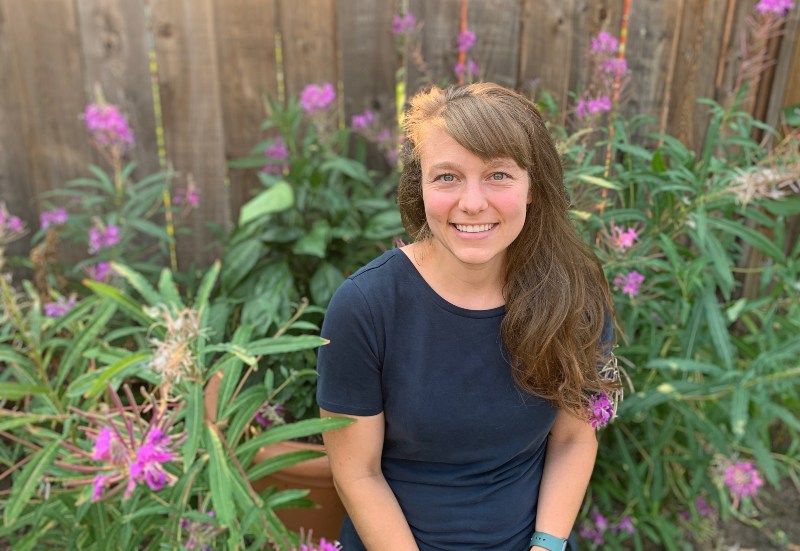Jenet Dooley defies labels (except for being a self-described “long-time swamp monster”). Yes, technically she is a wetland ecologist, but to Jenet, that title doesn’t adequately describe the interplay between the evolving nuances of ecology and the project management and coordination of monitoring programs. Like wetlands themselves, Jenet is hard to pin down, and she prefers it that way. Jenet didn’t start out to become a wetland ecologist, she came to it by way of an engineering degree, hard work, intuition, ingenuity, and exploration. Now, Jenet’s passion for wetlands is infectious. “Wetlands are a hot topic: people care about them, and I want to be able to answer questions about things that people care about.”
So what is a wetland ecologist? Jenet explains that wetland ecologists are interested in wetlands as systems and in the ways their different components interact, like how hydrology impacts the soils, or the community dynamics of wetland plants. Wetland ecologists need a broad base of knowledge, although they may have specialities. For Jenet, her area of choice is water quality: “It’s an easy way to look at a system as a whole and say if it’s doing well or not. And I like having a definitive way to talk about something in a way that is easy to understand.”
“Wetlands wasn’t something that I was targeting, it kind of happened. I just wanted to be outside.”
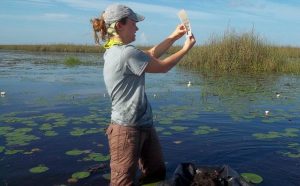
Jenet assessing soil in the Everglades.
Zig-zagging through Wetlands
Jenet’s path to being a wetland expert was a bit of a zigzag, but her strong connection to nature was always there. Growing up in Houston, Texas—the home of NASA—meant science and technology were all around, and Jenet always felt that science was an option for a career. Jenet grew up in Houston’s suburbs, which didn’t have a lot to offer in terms of the natural world. “From an environmental perspective it was so spread out, so much concrete, it’s made for cars… I learned how to drive on an 8-lane highway.” But Jenet’s parents made sure their children gained a love for the natural world, packing up three kids for hiking and camping trips in Colorado.
Jenet remembers being an advocate for animals as a child. “I recall yelling at another kid who chased a bunny and my mom bouncing a basketball on fire ants to kill them and I was so mad about it (now, thinking back, I know they are an invasive species).” As a teenager Jenet drove through cow fields to get to her high school. “In one of the fields was a wetland that would flood periodically and there were ducks in there, but then they concreted it over. It really upset me.”
In the Field
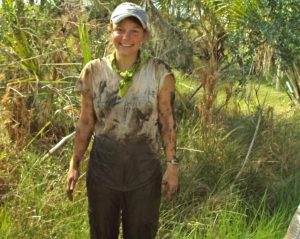
Jenet as a young swamp monster in grad school.
Jenet started her undergraduate degree in environmental engineering at Miami University in Ohio. “When I think of ecology versus engineering…engineering is very black and white, you can control a lot to solve problems versus the natural world and ecology, which is so much more ambiguous. I’ve gotten more into the nuances and complexity of the natural world throughout my career but I still really like those cleaner quantitative elements.”
Jenet learned to design public drinking water systems and spent a lot of time looking at spreadsheets and sizes of pipes and pumps. One summer, a summer internship on monitoring river water quality required her to spend a lot of time outside. “I just really liked it,” Jenet remembers, “you were literally in what you were studying and it was clear to me that was what I wanted to be doing.” Ultimately, this inspired her to leave consulting for graduate school at the University of Florida, where she would focus on ecological engineering. Jenet notes that making that jump from engineering to ecology was difficult. “It’s just a whole different mindset and I didn’t have the basic science classes, so finding that program was a way that I could get into the natural sciences.”
Her program had a strong focus on wetlands, and she did fieldwork for the National Wetland Condition Assessment (NWCA), a nationwide wetland monitoring program in the United States. It was the first year that it had been done and it was also Jenet’s first real introduction to wetlands. “We were out monitoring 70 different wetlands across Florida, it was amazing: it was mangroves, hardwood swamps…just everything. That’s when I got to know wetlands and I was like, ok this is it! I really love this!”
Jenet also started to get more interested in water quality during grad school. Due to the heat and humidity in Florida, algal blooms are common; monitoring nutrient levels and mitigating naturally occurring phosphorus in wetlands are hot topics. Jenet began working on more projects around water quality and hydrology, looking for differences in the pattern of nutrient levels.
From Florida to Alberta
We’re really thinking about the questions we want to answer with the data.
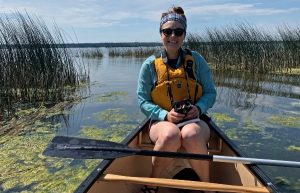
Jenet bird watching around Edmonton.
Jenet found her way to Alberta and to the ABMI through both luck and circumstance. Jenet was finishing her PhD at the University of Florida when her partner found a placement in Edmonton. Jenet hit the Internet and contacted everyone she could. “I’d Google ‘Alberta wetlands’ and see who would come up and I’d start emailing people and meeting them for coffee.”
One connection was Glynnis Hood, Vice Dean, wetland expert, and beaver researcher at the University of Alberta’s Augustana Campus. Glynnis became a mentor and suggested that Jenet apply to teach an undergraduate freshwater ecology course. She got the job, and ended up learning a lot about Alberta’s wetland flora and fauna herself. She then worked at a consulting company for several years, doing wetland assessments in the Edmonton Parkland Region. However, she missed flexing her science and research muscles, so when a wetland ecologist position came up at the ABMI she jumped at the opportunity.
There’s no typical day at the ABMI, and that suits Jenet just fine. She can be found coordinating and designing wetland monitoring programs, reviewing protocols, interpreting aquatic invertebrate and vascular plant data, developing training materials, in the field, and meeting with the ABMI’s wetland working group in a quest to design “Wetland 2.0” (a new and improved approach to monitoring and reporting on wetlands at the ABMI).
“It’s a lot of brainstorming, synthesizing ideas and planning what this new monitoring chapter is going to look like. We’re starting with the basics and asking questions like, “What are the pressures and stressors on wetlands in Alberta? What are the highest priority ones? What are the impacts of those stressors? What do they look like and how can we measure them? We’re really thinking about the questions we want to answer with the data.”
Another role that Jenet plays is as a strong collaborator and bridge-builder with other wetland practitioners in Alberta. She plays a strong role in the Oil Sands Monitoring (OSM) wetland program, working closely with Alberta Environment and Protected Areas (EPA). Working directly with EPA to support the implementation of a monitoring program has been a large undertaking: “I feel optimistic, there’s a lot of potential and I think it will grow, so I feel proud.” Jenet works with many organizations as part of the multitude of wetland programs she’s involved with. She feels lucky to get to work with so many different people, from field staff to taxonomists to our other ecologists.
In her spare time, Jenet continues to develop her skills as a member of the Alberta Native Plant Council and the Society of Wetland Scientists. Jenet is also an active member of her community league board, planning events such as Black History Month celebrations.
There’s More than One Path
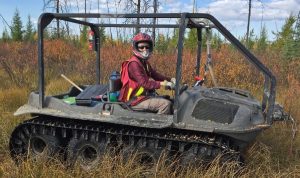
Field work for a wetland monitoring program during Jenet’s consulting days.
For aspiring wetland ecologists, Jenet stresses that there is more than one path—ecology can accommodate varied interests so it’s important to follow what makes one happy. Jenet suggests to not be in a rush to get through school, that there are other ways to gain valuable information in environmental fields. Jenet points to friends of hers who worked in nature-related positions before going to graduate school. “They came to grad school thinking about research with so much more background and experience and that really helped them,” she continues, “So I always think that if I were to do it again, I would be a guide somewhere for a few summers… Being out in nature, you’re absorbing a lot of important information. Data analysis and number crunching also require communicating the story, which is really going to come from that experience.” Jenet adds, “plus the longer you’re a scientist, the less field work you find yourself doing…so take the time to do it when you have the opportunity.”
Being a Scientist
Jenet says she feels lucky to have worked with so many fantastic women as supervisors, mentors, and colleagues throughout her scientific career. In graduate school her field team was mainly women, but she notes that’s pretty rare. She acknowledges facing some male biases and some uncomfortable, vulnerable moments in the field, but she says overall she believes things are getting better for women in science.
Jenet says a bigger issue is the fact that the “scientific community is very white-dominated…and maybe that’s the hill that we need to be climbing, and our focus should be more on people of colour which I find is really really lacking.”
A Bigger Seat for Wetlands
Jenet says her ideal project is (conveniently for us) Wetland 2.0, which will help us detect changes in wetlands over a shorter time span. However, she would like to see more and novel ways of analyzing and reporting on the wealth of data that the ABMI has. An exciting recent release of wetland data came in the form of the online Wetland Atlas of Alberta, which includes new ways of reporting on our aquatic invertebrate data. (Note: Jenet will be talking about the Wetland Atlas of Alberta in a webinar on March 21, 2023). Jenet is optimistic for the future and is glad to help shape the future of ABMI wetland monitoring.
Ultimately, Jenet hopes to see wetlands gain more public attention, have more buy-in from stakeholders, and generally “have a bigger seat at the table.” Jenet notes, “but as far as the work that we do, I am seeing it happen, we’re just at the beginning.”
- Hydrology is the study of the distribution and movement of water both on and below the Earth’s surface, as well as the impact of human activity on water availability and conditions. (National Geographic Society)
Resources & Links
- Jenet Dooley Twitter
- ABMI eDNA Pilot Project
- National Wetland Condition Assessment (NWCA)
- Alberta Native Plant Council
- Society of Wetland Scientists
- Wetland Atlas of Alberta
- Oil Sands Monitoring Program

